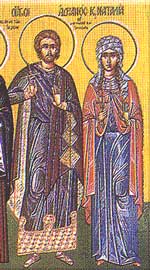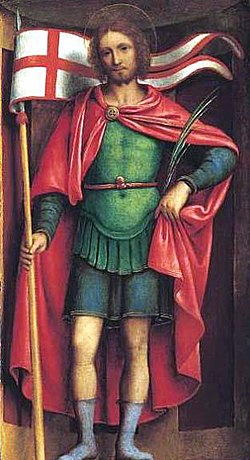Top Qs
Timeline
Chat
Perspective
August 26 (Eastern Orthodox liturgics)
From Wikipedia, the free encyclopedia
Remove ads
August 25 - Eastern Orthodox liturgical calendar - August 27

All fixed commemorations below are observed on September 8 by Orthodox Churches on the Old Calendar.[note 1]
For August 26, Orthodox Churches on the Old Calendar commemorate the Saints listed on August 13.
Saints
- Martyrs Adrian and Natalia of Nicomedia,[1] and 23 companions (306)[2][3][4][5][note 2][note 3]
- Martyrs Atticus and Sissinius, by the sword.[4][6]
- Martyr Adrian, son of Roman Emperor Probus, at Nicomedia (320)[4][7][note 4]
- Saint Gelasius.[9]
- Saint Maximus III, Archbishop of Jerusalem (347)[2] (see also: May 9)
- Venerable Tithoes of the Thebaid (4th century), disciple of St. Pachomius the Great.[2][4][10][note 5]
- Monk Ioasaph, Prince of India (4th century)[2][4][11] (see also: November 19)
- Venerable Ibestion the Confessor, Egyptian ascetic (c. 450)[2][4][12]
Remove ads
Pre-Schism Western saints
- Saint Zephyrinus, Pope of Rome from 199 to 217, who defended Orthodox Christology against heresies (217)[13]
- Martyrs Irenaeus and Abundius (258)[13][note 6] (see also: August 13)
- Saint Secundus, a soldier of the Theban Legion martyred near Ventimiglia in Italy (3rd century)[13]
- Saint Alexander of Bergamo (c. 303)[13][note 7][note 8]
- Saint Ninian, Apostle to the Southern Picts (432)[13][note 9]
- Saint Rufinus, Bishop of Capua (5th century)[13][note 10]
- Saint Elias of Syracuse, a monk who became Bishop of Syracuse in Sicily (660)[13]
- Saint Felix of Pistoia, a holy hermit in Pistoia in Tuscany in Italy (9th century)[13]
- Saint Pandwyna (Pandionia), a holy virgin born in Ireland (c. 904)[note 11]
- Saint Victor (Vitores), a priest in Spain martyred by the Moors in the ninth or tenth century.[13]
Remove ads
Post-Schism Orthodox saints
- Saint Zer-Jacob, missionary of Ethiopia.[2][15][16]
- Saint Adrian of Uglich (after 1504), disciple of St. Paisius of Uglich.[2][16][17]
- Saint Adrian of Ondrusov, founder of Ondrusov Monastery, Karelia (1549)[2][18]
- Blessed Cyprian of Storozhev, former outlaw (16th century)[2][16]
- Saint Maria (Fedina) of Diveyevo, Fool-for-Christ (1931)[2][16]
New martyrs and confessors
- New Hieromartyr Peter Levlev, Priest (1918)[19]
- George Kossov of Orlov (1928)[15]
- New Hieromartyr Nectarius (Trezvinsky), Bishop of Yaransk (1937)[2][16]
- New Hiero-confessor Roman Medved of Moscow, Archpriest (1937)[2][15]
- New Hieromartyr Victor Ellansky, Priest (1937)[15]
- New Martyrs Demetrius Morozov and Peter Bordan (1937)[15]
Other commemorations
- Commemoration of the Meeting of the "Vladimir" Icon of the Most Holy Theotokos (1395)[2][15][20]
- Icon of the Mother of God "Virgin of Tenderness" of the Pskov Caves (1524).[15][21][note 12]
- Finding of the relics (1748) of St. Bassian, Schemamonk of Alatyr Monastery (c. 1698)[2][16]
- Miraculous Self-Renewal of the Vladimir Icon of the Most Holy Theotokos in the hands of Righteous Abbess Rufina, in Harbin, Manchuria (1925)[2][15][16]
Remove ads
Icon gallery
- Martyrs Adrian and Natalia of Nicomedia.
- St. Alexander of Bergamo.
- St. Ninian, Apostle to the Southern Picts.
- St. Adrian of Ondrusov.
- "Vladimir" Icon of the Most Holy Theotokos.
Notes
- The notation Old Style or (OS) is sometimes used to indicate a date in the Julian Calendar (which is used by churches on the "Old Calendar").
The notation New Style or (NS), indicates a date in the Revised Julian calendar (which is used by churches on the "New Calendar"). - (in Greek) Τὰ ὀνόματα τοὺς εἶναι:
- Ἀνατόλιος, Ἄνθιμος, Ἀντίοχος, Γεντήλιος, Ἐλευθέριος, Ἐρμογένης, Εὐήθιος, Εὐρετός, Εὐτύχιος, Θεαγώνης, Θεόδωρος, Θῦρσος, Ἰωάννης, Καρτερᾶς, Κλαύδιος, Κυριάκος, Μαρίνος, Μαρδώνιος, Μηνώδιος, Πλάτων, Συνετός, Τρωάδιος καὶ Φαρέτριος († 4ος αἰ.).
- He is mentioned in the Evergetinos.
- Patron of Bergamo in the north of Italy, where a church has been dedicated to him from the fourth century. A later manuscript suggests that he was a centurion of the Theban Legion who escaped from prison but was recaptured.
- A Briton who was sent to enlighten his native country. He established his mission at Whithorn in Wigtownshire in Scotland, so called because the church was built of stone plastered white. There was a monastery attached to it and it was from this centre that Ninian and his monks enlightened the northern Britons and the Picts.
- His relics are enshrined in the cathedral.
- "ST. PANDWYNA, or PANDONIA, was the daughter of a petty prince of Ireland or North Britain, who fled to England to escape the tyranny of her father and the pursuit of those who would have compelled her to abandon her purpose of serving God in the state of holy virginity. She took refuge with a kinswoman of hers, who was prioress of a nunnery at Eltisley in Cambridgeshire. There she led a life of great perfection, and obtained the reputation of eminent sanctity. She was buried near a well, which bears her name, and at a later period her sacred relics were translated to the parish church, which still bears the title of 'St. Pandonia and St. John the Baptist.'"[14]
Remove ads
References
Sources
Wikiwand - on
Seamless Wikipedia browsing. On steroids.
Remove ads





